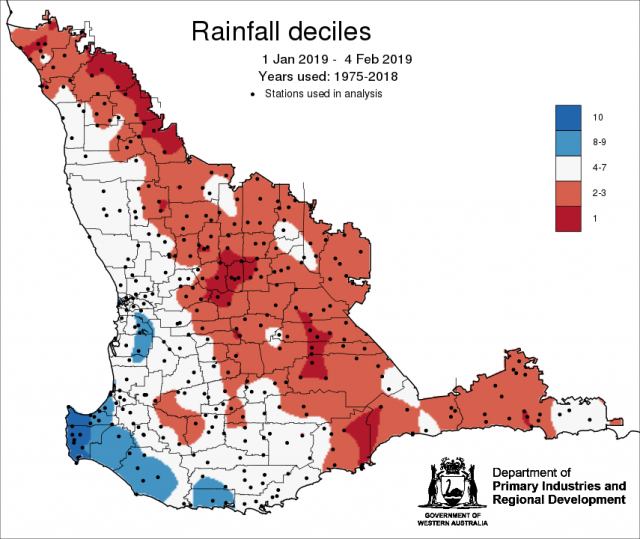Recent climate
January rainfall was generally below average to average in the SWLD. January maximum temperatures were average to above average and minimum temperatures were below average to average. Rainfall to date decile map for 1 January to 4 February 2019 shows much of the grainbelt has received less rainfall (decile 2-3) than usual based on historical rainfall for the years 1975-2018.
In January, the atmospheric pressure was above normal over most of Australia. The Southern Ocean is likely to see higher pressures and weaker westerly winds, most noticeable during February, to the southwest of Australia. This may reduce rainfall across parts of southern Australia.
The Indian Ocean sea surface temperatures off the western WA coastline is expected to remain cooler than average, reducing the amount of moisture evaporated off the eastern Indian Ocean, and therefore likely limiting moisture flowing into Western Australia.
The Southern Annular Mode (SAM), also known as the Antarctic Oscillation (AAO), describes the north–south movement of the westerly wind belt that circles Antarctica, dominating the middle to higher latitudes of the southern hemisphere. SAM is currently positive. In a positive SAM event, the belt of strong westerly winds contracts towards Antarctica, resulting in weaker than normal westerly winds and higher pressures over southern Australia, restricting the penetration of cold fronts inland. Models indicate that SAM is likely to remain positive until mid-February.
The Indian Ocean Dipole (IOD) is neutral. The IOD typically has little influence on Australian climate from December to April. The El Nino Southern Oscillation (ENSO) remains neutral. There is a 50% chance of an El Nino developing during autumn. El Nino’s typically result in warmer and drier than usual conditions, and a later autumn break for southern and eastern Australia. Further information can be obtained from the Bureau of Meteorology’s ENSO Wrap Up.
The table below gives a summary of past month and three-month southwest Western Australia (SWWA) climate conditions, and can indicate what is likely to occur in the near future if climate conditions follow the current pattern.
| Climate Indicator | Past month | Past 3 months |
| SWWA Rainfall | Below average to average | Below average to average |
| SWWA Mean Temperature | Average to above | Average to above |
| SWWA atmospheric pressure | Above Normal | Above Normal |
| Indian Ocean Sea surface temperature | Cooler | Cooler |
| El Niño/Southern Oscillation (ENSO) | Neutral | Neutral |
| Indian Ocean Dipole (IOD) | Neutral | Neutral |
| Southern Annular Mode (SAM) | Positive | Positive |

